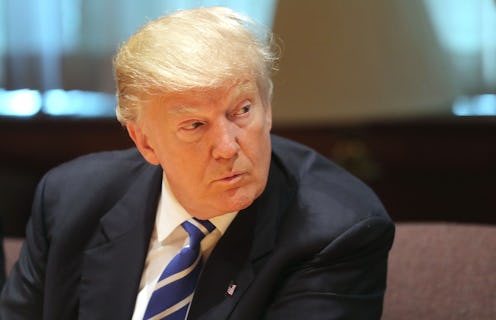Life
What Facial Recognition Reveals About The Debate
There are a lot of ways you can evaluate a debate — from attitude to debate etiquette to wacky things like policy ideas to even... facial recognition? Yes, that's right, Vocativ used facial recognition software to evaluate the first presidential debate, and the results are certainly interesting. But then, is there anything boring about the 2016 election cycle? (The answer is no. This election is many things, but it is certainly not boring.)
The presidential debate on Monday, Sept. 26 was the first of three debates between the two presidential nominees this year before the November election. The consensus seems to be that Hillary Clinton did much better than Donald Trump, with polls suggesting most Americans think she was the winner. Indeed, to many observers — who weren't shy about sharing their feelings on social media — it seemed clear that Trump was unprepared, and that Clinton was able to knock him off his game rather easily.
But is that the truth, or just a convenient narrative? After all, people's perception is often swayed by a number of unconscious factors and might not be objective. Therefore, it's useful to look at what facial recognition software has to say about this. Because facial recognition software can catch things that humans miss.
Fortunately, this year for the first time, the debate was broadcast as a split screen, allowing viewers to see both candidates throughout. This therefore enabled us to see and analyze the candidates' reactions to one another.
So was Hillary Clinton as commanding and unshakable as she seemed? Was Donald Trump as flustered and emotionally volatile as he appeared? Well, according to Vocativ, most of the time the candidates kept a pretty even keel. But there were a few instances where their facial expressions were revealing:
1. Sadness
When Hillary Clinton said that Trump lives in his own reality, she got a positive response from the audience — and a negative one from Trump. Facial recognition software suggested he was notably sad at this moment.
2. Anger
Donald Trump is on record as one of the loudest and most persistent voices questioning whether Barack Obama was born in America, but in recent weeks he's tried to shift blame for the origins of the "birther" theory onto Clinton. When asked about it at the debate, Trump's response made Clinton notably angry, according to facial recognition.
3. Distress
Donald Trump has said numerous sexist things over the course of his public life, and even over the course of this recent campaign. But apparently he doesn't like having people point that out. When Hillary Clinton took him to task for the way he talks about women — she accurately described him as "someone who has called women pigs, slobs, and dogs" — he was apparently notably distressed.
4. Happiness
If you thought Hillary Clinton seemed genuinely happy when Donald Trump bizarrely accused her of having an ill-suited temperament, you'll be happy know the software agrees. Clinton registers here as extremely happy.
So what does this tell us? Well, four moments don't necessarily reveal a ton, and Vocativ hasn't released more of their analysis at the time of this writing. But it seems there were emotional moments for both candidates. Hillary Clinton seems understandably angered when accused of something she demonstrably did not do — especially when it's something that was hurtful to the president she has worked with closely. But some of Trump's outrageous statements also clearly amuse her quite a bit.
Trump, on the other hand, seems sad when presented with evidence that maybe people don't love him — and distressed when someone says something that he didn't seem to have an answer for.
Make of that what you will.
Images: Vocativ/YouTube (4)
